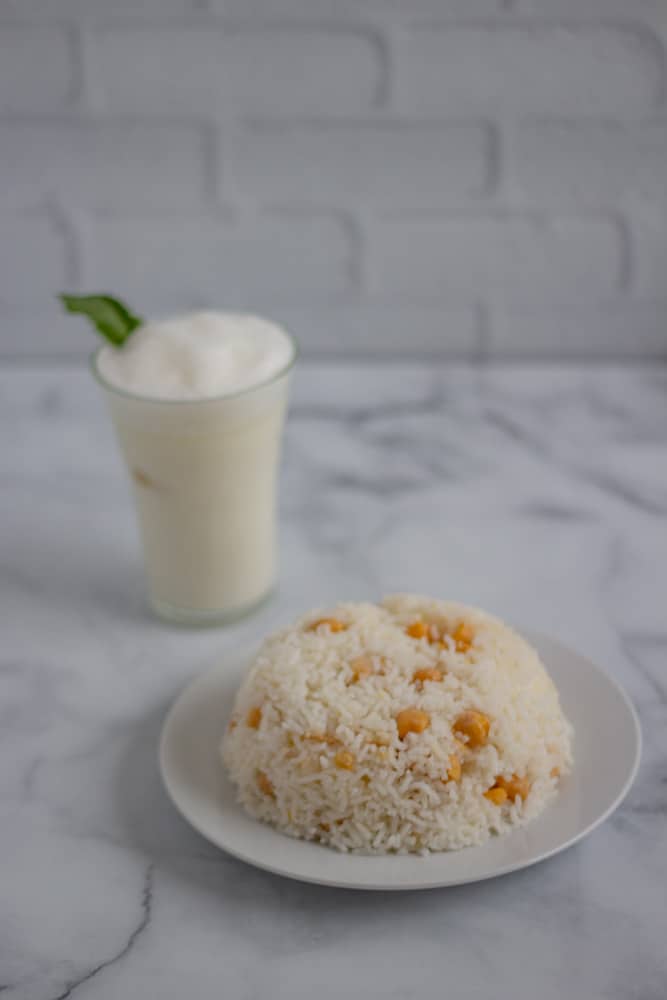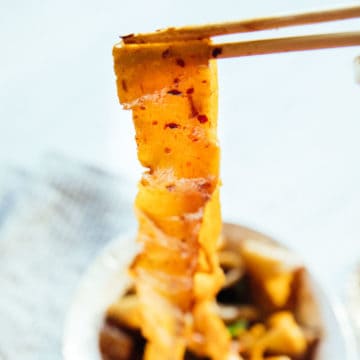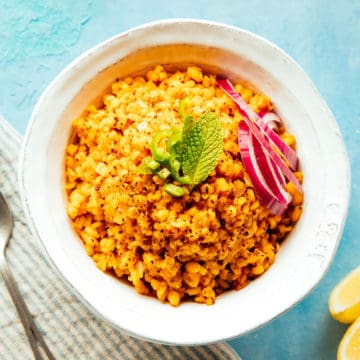
Turkish rice pilaf with chickpeas is one of my favorite street foods. It reminds me of late nights out with friends, sitting on the curb and devouring it in enamel dishes provided by the vendor before we all catch a bus home. Not every nohutlu pilav you see on the street is vegan, however, since vendors often use chicken broth and butter to flavor their rice. Luckily, veganizing it at home is very easy.
In this recipe I will share all the details of how us Turks generally cook rice. I realize that “rice” may not sound too exciting, but trust me, there are vast differences between how each culture cooks theirs.
Essential Steps to make the best Turkish Rice Pilaf with Chickpeas
Following steps will ensure a flavorful bite of pilaf with distinct pearl-like grains. Rice that sticks together is the opposite of what we are going for to optimize this scrumptious yet humble meal.
1- Use the right type of rice.
Since this is a Turkish recipe, we will use white Baldo rice. This type is not always very easy to find so feel free to use Arborio instead. You can also make it whole grain by substituting brown or red by adjusting the cooking times, but the result won’t be nearly as creamy.
Another crucial detail is to...
2- ...Always rinse
Otherwise you may as well throw some rice into the rice cooker and make sticky rice instead. Even though I love that style as well, we are trying to avoid sticky at all costs in this one. So rinse off as much starch as you can while you prep.
3- Turks use lots of oil in their rice
Usually both saturated and unsaturated kinds in the form of sunflower oil and butter. I try to avoid oil, especially saturated ones, but always make an exception for special recipes.
4- Broth matters
You can choose to use vegetable stock or a bouillon alternative. I love the Better than Bouillon brand to substitute chicken stock.
5- Get creative
Don’t get me wrong, I love rice as is, but it can get quite boring after a while. In Turkish cuisine, depending on the specific region, there are many extra ingredients you can experiment with. My hometown, Izmir, loves to add peas and carrots. Other places will add orzo or vermicelli, or, as with this recipe-- chickpeas.
6- Don’t forget to cover your rice with a dish/paper towel at the end
This step is crucial if you want to impress with very distinct grains of rice. Otherwise, the liquidating steam on the lid will drip back inside the pot. Again, we are going for the opposite of sticky rice.

Optimizing Nutrition
Butter, salt, vegetable oil, white rice... this recipe is far from WFPB. You can omit the oils and salt, sub brown or red rice— but at that point it won't be anywhere close to the traditional recipe. It will be a regular pot of grains fit for Buddha bowls. That is why I make rice this way as a treat every now and then, usually on weekends or for guests. [May 2020 Edit] ...or during quarantine, as we try to maximize any sensory excitement provided by our pantry staples.
However, you can still use the earlier tips (rinsing and covering) for less sticky varieties of a healthier version of pilaf.
Uses for Turkish Rice Pilaf with Chickpeas
You can use this recipe pretty much anywhere you would otherwise be having rice. Here are some of my favorite uses for and sides to pilaf:
- Vegetable stew
- Olive-oil dishes
- Vegan kofta
- Ayran (frothy yogurt drink)
- Pickles
📖 Recipe

Turkish Rice Pilaf with Chickpeas: Nohutlu Pilav
- Total Time: 1 hour
Ingredients
2 cups white rice (Baldo or Arborio)
2 tablespoon vegetable oil
2 tablespoon butter alternative (I used Earth Balance)
3 cups hot water or vegetable stock (if using a bouillon, add it to hot water first then mix thoroughly)
1 cup chickpeas (I used canned. Don’t discard the chickpea water! You can create wonderful recipes with aquafaba later)
1 teaspoon salt (omit if using bouillon)
Instructions
- Rinse the rice until water runs almost clear then soak it in salted water for at least 20 minutes. Rinse again, drain the water, and set aside.
- In a wide pot, add the oil and butter until they are hot. You can test this by carefully throwing in a grain of rice or a drop of water and waiting for the hiss sound.
- Add the drained rice into the pot and stir fry for a few minutes or until the rice gets mostly transparent.
- Add the boiling water & salt/bouillon, or stock, then stir in the rinsed and drained chickpeas.
- Cover the pan and cook on medium heat until you see multiple pockets of air popping up. At this point, turn down the heat to low, and cook covered until all the water has been absorbed and the rice softens to your liking, usually 30-40 minutes.
- Cover with a dish or paper towel, and put the lid on top. Let it rest like this for at least 10 minutes. Serve hot as a main or side dish with ayran.
- Prep Time: 20 minutes
- Cook Time: 40 minutes
- Category: Mains
- Cuisine: Turkish
Nutrition
- Serving Size:
- Calories: 1933
- Sugar: 6.4 g
- Sodium: 4881 mg
- Fat: 45.5 g
- Carbohydrates: 337.5 g
- Protein: 38.5 g
- Cholesterol: 0 mg






Hannelore
I love your cooking.
Gönül
That is so kind of you, thank so much! 🙂